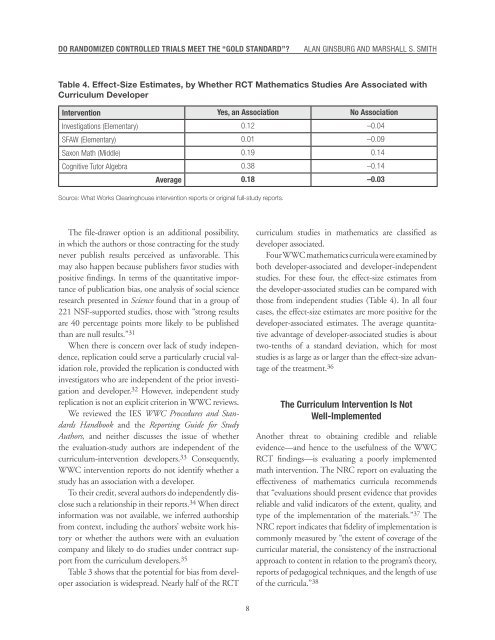Do Randomized Controlled Trials Meet the “Gold Standard”?
Do-randomized-controlled-trials-meet-the-gold-standard
Do-randomized-controlled-trials-meet-the-gold-standard
You also want an ePaper? Increase the reach of your titles
YUMPU automatically turns print PDFs into web optimized ePapers that Google loves.
DO RANDOMIZED CONTROLLED TRIALS MEET THE “GOLD STANDARD”?<br />
ALAN GINSBURG AND MARSHALL S. SMITH<br />
Table 4. Effect-Size Estimates, by Whe<strong>the</strong>r RCT Ma<strong>the</strong>matics Studies Are Associated with<br />
Curriculum Developer<br />
Intervention Yes, an Association No Association<br />
Investigations (Elementary) 0.12 –0.04<br />
SFAW (Elementary) 0.01 –0.09<br />
Saxon Math (Middle) 0.19 0.14<br />
Cognitive Tutor Algebra 0.38 –0.14<br />
Average 0.18 –0.03<br />
Source: What Works Clearinghouse intervention reports or original full-study reports.<br />
The file-drawer option is an additional possibility,<br />
in which <strong>the</strong> authors or those contracting for <strong>the</strong> study<br />
never publish results perceived as unfavorable. This<br />
may also happen because publishers favor studies with<br />
positive findings. In terms of <strong>the</strong> quantitative importance<br />
of publication bias, one analysis of social science<br />
research presented in Science found that in a group of<br />
221 NSF-supported studies, those with “strong results<br />
are 40 percentage points more likely to be published<br />
than are null results.” 31<br />
When <strong>the</strong>re is concern over lack of study independence,<br />
replication could serve a particularly crucial validation<br />
role, provided <strong>the</strong> replication is conducted with<br />
investigators who are independent of <strong>the</strong> prior investigation<br />
and developer. 32 However, independent study<br />
replication is not an explicit criterion in WWC reviews.<br />
We reviewed <strong>the</strong> IES WWC Procedures and Standards<br />
Handbook and <strong>the</strong> Reporting Guide for Study<br />
Authors, and nei<strong>the</strong>r discusses <strong>the</strong> issue of whe<strong>the</strong>r<br />
<strong>the</strong> evaluation-study authors are independent of <strong>the</strong><br />
curriculum-intervention developers. 33 Consequently,<br />
WWC intervention reports do not identify whe<strong>the</strong>r a<br />
study has an association with a developer.<br />
To <strong>the</strong>ir credit, several authors do independently disclose<br />
such a relationship in <strong>the</strong>ir reports. 34 When direct<br />
information was not available, we inferred authorship<br />
from context, including <strong>the</strong> authors’ website work history<br />
or whe<strong>the</strong>r <strong>the</strong> authors were with an evaluation<br />
company and likely to do studies under contract support<br />
from <strong>the</strong> curriculum developers. 35<br />
Table 3 shows that <strong>the</strong> potential for bias from developer<br />
association is widespread. Nearly half of <strong>the</strong> RCT<br />
curriculum studies in ma<strong>the</strong>matics are classified as<br />
developer associated.<br />
Four WWC ma<strong>the</strong>matics curricula were examined by<br />
both developer-associated and developer-independent<br />
studies. For <strong>the</strong>se four, <strong>the</strong> effect-size estimates from<br />
<strong>the</strong> developer-associated studies can be compared with<br />
those from independent studies (Table 4). In all four<br />
cases, <strong>the</strong> effect-size estimates are more positive for <strong>the</strong><br />
developer-associated estimates. The average quantitative<br />
advantage of developer-associated studies is about<br />
two-tenths of a standard deviation, which for most<br />
studies is as large as or larger than <strong>the</strong> effect-size advantage<br />
of <strong>the</strong> treatment. 36<br />
The Curriculum Intervention Is Not<br />
Well-Implemented<br />
Ano<strong>the</strong>r threat to obtaining credible and reliable<br />
evidence—and hence to <strong>the</strong> usefulness of <strong>the</strong> WWC<br />
RCT findings—is evaluating a poorly implemented<br />
math intervention. The NRC report on evaluating <strong>the</strong><br />
effectiveness of ma<strong>the</strong>matics curricula recommends<br />
that “evaluations should present evidence that provides<br />
reliable and valid indicators of <strong>the</strong> extent, quality, and<br />
type of <strong>the</strong> implementation of <strong>the</strong> materials.” 37 The<br />
NRC report indicates that fidelity of implementation is<br />
commonly measured by “<strong>the</strong> extent of coverage of <strong>the</strong><br />
curricular material, <strong>the</strong> consistency of <strong>the</strong> instructional<br />
approach to content in relation to <strong>the</strong> program’s <strong>the</strong>ory,<br />
reports of pedagogical techniques, and <strong>the</strong> length of use<br />
of <strong>the</strong> curricula.” 38<br />
8



